Wide-area video distribution experiment
using ultrahigh-definition video
~ Succeeded in wide-area 400G connection, NMOS multi-vendor operation,
EVPN over SR-MPLS experiment ~
<2 to 11 February 2022>
The National Institute of Information and Communications Technology (NICT) ICT Testbed R&D Promotion
Center provides various testbed environments including the Network Testbed JGN*1, as a demonstration platform for domestic
companies, universities and other research institutions.
In February 2022, NICT and approximately 70 organizations from industry, academia, and government
gathered their technologies, human resources, and equipment to perform a demonstration experiment.
Using recorded video taken in Nago City, Okinawa Prefecture, and live video from Sapporo City,
Hokkaido, we realized: multiple ultrahigh-definition 8K*2uncompressed video transmission and processing
experiments, Networked Media Open Specifications (NMOS) multi-vendor remote production experiments,
penetration and load tests, and large-scale remote experimental operations, on wide-area 400 Gbps
line and EVPN (Ethernet Virtual Private Network) over SR-MPLS (Segment Routing - Multi-Protocol
Label Switching) environment.
Background of the Experiment
Due to the COVID-19 environment that has persisted since the year before last, the communications and broadcasting fields is undergoing some major workflow changes, such as dispersion of operators, remote operations or filming/production constraints. In this experiment, in order to pursue the issues of COVID-19 time video production and network operation technology by ensuring operational continuity as well as avoiding spreading the infection, we conducted a demonstration experiment improving wide-area distribution of ultra-high-definition video by incorporating ultra-high-speed networks along with the latest technologies and standards.
Achievements
(1) World's first wide-area 400 Gbps connection and line operation
We have realized a 400 Gbps
connection across a wide-area between Sapporo, Tokyo and Osaka
linking multiple organizations, operated these line, and transmitted data at more
than 300 Gbps. This wide-area 400 Gbps line connection realized on January 27, 2022, was the world's first example of a wide-area
and multiple organizations connection.
This 400Gbps experimental line crossing
through the country was made possible through the cooperation of the National Institute of Informatics (NII); which
constructed and provided SINET6, the Industrial Cyber Security Center of Excellence
(ICSCoE) of the Information-technology Promotion Agency, Japan (IPA), the Cyber Kansai Project
(CKP) and ARTERIA Networks Corporation.

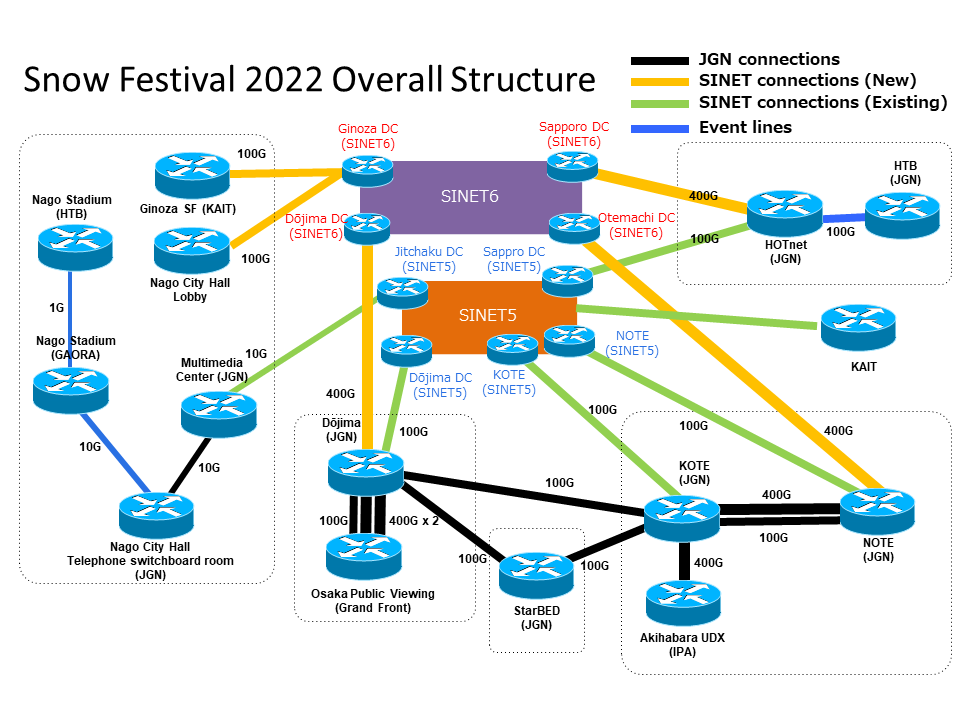
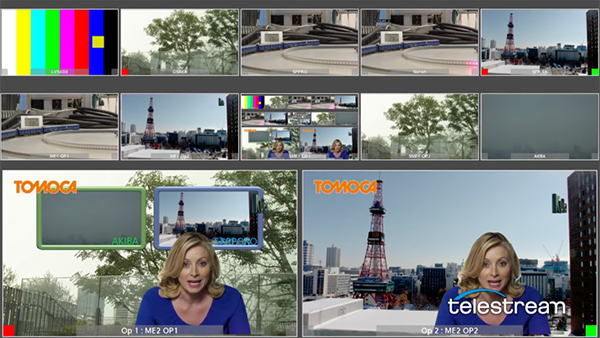
(2) Multi-vendor IP remote production experiment using NMOS
To improve interoperability
between different environments where different manufacturers and multiple types of
video equipment products coexist, a technicalstandard and API called NMOS (Network Media Open
Specification) are being developed under the initiative of AMWA (Advanced Media Workflow
Association). In this experiment, it was confirmed that a pseudo production center set
up in Tokyo can automatically detect, register, control, change settings, and transmit video
from equipment of multiple manufacturers set up in Sapporo, Osaka and other
locations.
As for video materials, video and audio from 4K cameras installed in Sapporo and Osaka, HD
signals from 8K cameras in Sapporo and HD signals encoded with JPEG-XS codec were transmitted
via experimental lines and combined into one video at the Tokyo production center,
together with HD signals from 4K cameras installed in the center and other
stored video materials.
In addition, since remote production and broadcasting technology requires time
synchronization by PTP (Precision Time Protocol) for high-precision synchronization in the order
of 1 µ(micro) second
, in this experiment, PTP generated in Nara was transmitted to Sapporo, Tokyo and
Osaka via the network, thereby realizing video synchronization and PTP time synchronization
between Sapporo, Tokyo and Osaka.
(3) Switching video stream transmission paths using EVPN over SR-MPLS
We set up a video transmission network used for remote production over multiple paths with
different physical routes of EVPN over SR-MPLS and conducted an experiment to switch between
these paths during video transmission. It was an experiment of seamless (hitless) switching
between transmission lines as specified in SMPTE ST 2022-7. Good results were obtained to the
extent that the switching was almost unrecognizable for the end user in the output
video. In the future, the feasibility of implementing SDN
controllers for content production systems (to perform route selection and resource allocation
in consideration of bandwidth management and load balancing) is expected to become a challenge
for the industry to consider.
(4) Penetration and load testing of video control equipment and network
equipment
Under the leadership of the Industrial Cyber Security Center of the Information-technology
Promotion Agency, Japan (IPA), various penetration tests of video control equipment and network
devices were conducted as in the previous year. This year, we organized not only a penetration
implementation team but also an incident response team for the penetrated systems and were able
to identify multiple problems ranging from inadequate configuration to insufficient
implementation and protocol issues. In particular, we were able to uncover many issues,
including previously unknown vulnerabilities related to IP multicast and NMOS. The results were
fed back to the experiment participants, contributing to the enhancement of software and
equipment security.
We also conducted a load test by DoS on 400 Gbps line and network equipment and recorded 395
Gbps of load traffic transmission between Tokyo and Osaka.
Configuring parts of 400 Gbps transmission section with 400 Gbps LAG (Link Aggregation
Group) allowed us to identify problems such as inability to receive video materials
normally due to reordering, and the inability to transmit at wire rate due to problems with the
handling of short packets in some routers. We also provided feedback to network equipment
vendors.
(5) Various distribution experiments and performance evaluations using ultra-high
definition 8K uncompressed video, etc.
We conducted an 8K multicast delivery experiment from a distributed VM (Virtual Machine) using
an NFV (Network Functions Virtualization) server on SINET5. We also conducted a service chaining
experiment in which multiple video processing services were connected on the communication path,
using images from 8K cameras installed in Sapporo and Okinawa and 8K video materials stored in
StarBED*3. This time, we newly implemented a
software-based video processing function that performs format conversion of 8K uncompressed
video at over 10 Gbps and conducted a real-time video production experiment using a software
packet switch in conjunction with video switching processing.
Many other participating organizations were conducting experiments in parallel, including
multicast transmission experiments using 8K low-latency compressed transmission equipment,
evaluation of the characteristics of each company's 8K video transmission equipment during
traffic transmission and 100Gbps-class traffic monitoring.
About the Experiments
The main 8K video source was shot in Okinawa in advance, then stored in
and distributed from StarBED, a testbed provided by NICT.
The recording and distribution of the video was made possible mainly
thanks to companies and universities conducting joint research with NICT, and the
construction of the experimental system was made possible by the participation of
numerous companies. The experimental environment for the network and 8K video
distribution was a multi-vendor configuration built by combining prototype equipment and
products under development brought in by each company, and the development team itself improved
the software and reconfigured the hardware as the experiment progressed.
The experiments also served as a place for collaboration between industry, academia, and
government through the Cyber Kansai Project, as well as for the sharing of technical knowledge
and human resource development among university students, corporate researchers, and engineers.
These experiments were conducted with the cooperation and sponsorship of the [Participating
Organizations in the Demonstration Experiment] listed below.
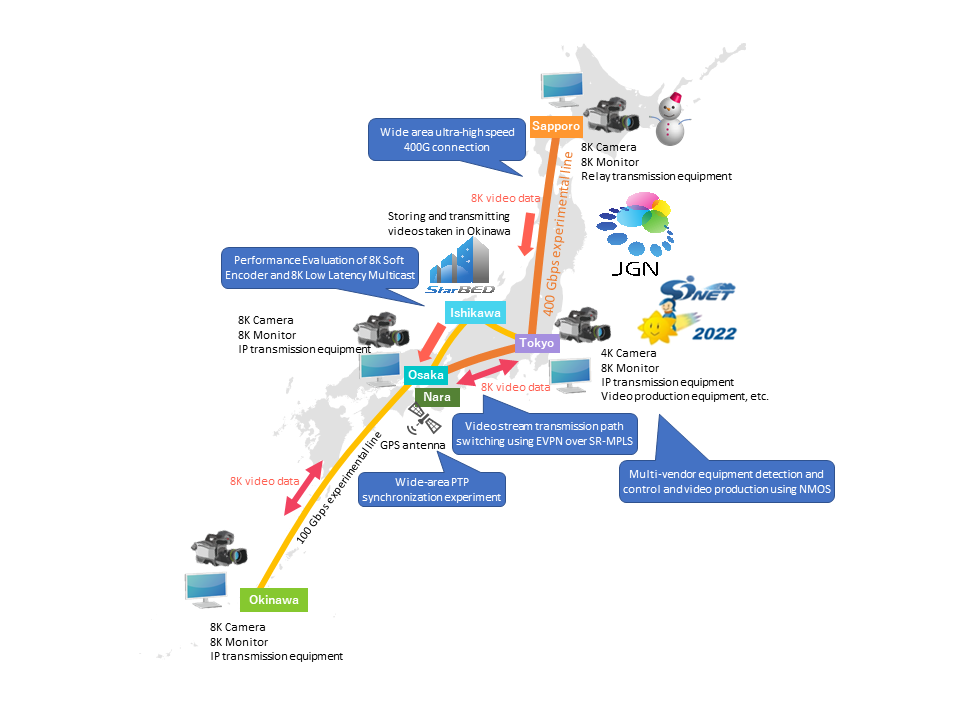
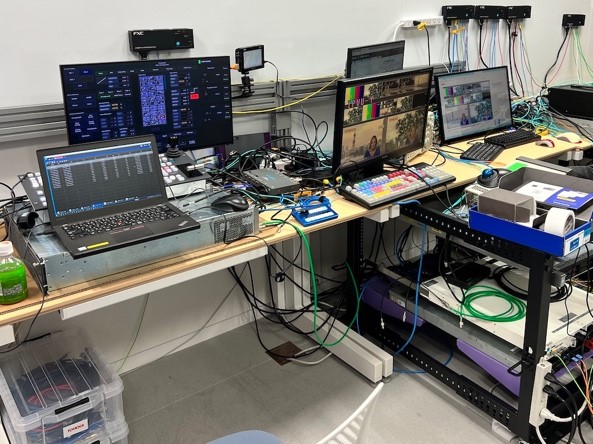
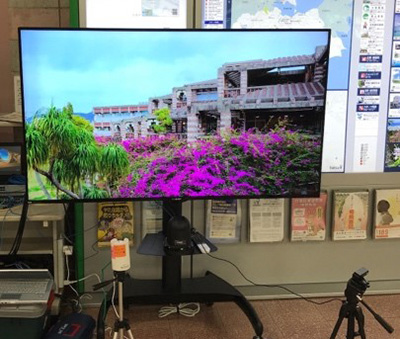
Future Perspective
Since 2003, we have been working on the latest technological challenges through this video
distribution experiments every year. This year, too, despite the constraints of unmanned and
remote operations for many of the experiments and operations, we were able to achieve numerous
results, including ultra-high-speed and broadband network operation, multi-vendor operation of
video equipment, 8K video transmission and service chaining using virtual networks and the
discovery of new vulnerabilities and security flaws. Building on the success of this experiment,
we will continue to support the development of 8K video relay technology in Japan through the
concerted efforts of each organization.
| *1 JGN: | A high speed R&D network testbed for ICT technology development, constructed and
operated by NICT in Japan and overseas. The testbed provides domestic and overseas
experimental sites and lines connecting them with the maximum bandwidth of 400 Gbps.
[JGN
site] |
| *2 8K: | 4K is a high-quality TV standard and has 8 million pixels, four times the number of
pixels of the current Full HDTV (approximately 2 million), to achieve high-definition
image quality. The 4K standard for broadcasting has 3,840 horizontals by 2,160 vertical
pixels and is known as 4K because it has approximately 4,000 pixels in the horizontal
direction. In Japan, test broadcasting began in 2014, commercial broadcasting began in
2015 on CS broadcasting and cable TV, and practical broadcasting began in 2018 on BS. 8K
is a TV standard being developed mainly by NHK Broadcasting Technology Research
Laboratories.
It has 33 million pixels, which is about four times that of 4K and 16 times that of the
current full high-definition TV. The number of pixels is 7,680 horizontals by 4,320
verticals. It is called 8K because the number of pixels in the horizontal direction is
approximately 8,000 and is also called Super Hi-Vision. 8K practical broadcasting
started by NHK on BS in 2018. In this experiment, a dual-green system with eight 3G-SDI signals and a full-size 8K system with four 12G-SDI signals were used for the uncompressed sections, requiring approximately 24 Gbps and 48 Gbps per stream for communication, respectively. |
| *3 StarBED: | A testbed environment that NICT has been operating since 2002 to verify software and
hardware for real-world environments by running them on a large number of PCs.
[StarBED
site] |
- National Institute of Information and Communications Technology(NICT)
- • Hokkaido Television Broadcasting Corporation (HTB)
- • GAORA Inc.
- • Mainichi Broadcasting System, Inc.
- • NTT Communications Corporation
- • NTT TechnoCross Corporation
- • NTT Advanced Technology Corporation
- • NHK Technologies, Inc.
- • Nippon Telegraph and Telephone West Corporation (NTT West)
- • KDDI Corporation
- • Hokkaido Telecommunications Network Co., Inc. (HOTnet)
- • Exio Group, Inc.
- • Orbis, Inc. (OBIS)
- • Trust Communication Inc.
- • Fatware Inc.
- • Arista Networks Japan Limited.
- • FXC Inc.
- • Keysight Technologies Japan K.K.
- • Cisco Systems G.K.
- • Juniper Networks, Inc.
- • Palo Alto Networks, Inc.
- • Fortinet Japan G.K.
- • Astrodesign Inc.
- • Alpha Code, Inc.
- • Ikegami Tsushinki Co., Ltd.
- • Village Island Co., Ltd.
- • Grass Valley K.K.
- • SunElena Co., Ltd
- • Sharp Corporation
- • Seiko Solutions Inc.
- • SOUM Corporation
- • T Spot Co., Ltd.
- • Techno House Inc.
- • Digital Research Inc.
- • Telestream Japan LLC
- • TOiNX Tohoku Information Systems Company, Incorporated
- • Tomoka Electrics Co., Ltd.
- • Macnica, Inc.
- • Nvidia Corporation
- • PacketLight Networks Ltd.
- • iLand6 Co., Ltd.
- • Pure Logic Co., Ltd.
- • Furukawa Network Solutions Corporation (FITELnet)
- • Mihal Telecommunications Inc.
- • TelHi Corporation
- • Rikei Corporation
- • Riedel Communications K.K.
- • ALAXALA Networks Corp.
- • Leader Electronics Corporation
- • Photron Limited
- • Otaritech Corp.
- • Digicas LLC.
- • Hibino Corporation
- • Hibino Intersound Corporation
- • Servants International Inc.
- • Internet Initiative Japan Inc.
- • ARTERIA Networks Corporation
- • Osaka Gakuin University
- • Kanagawa Institute of Technology
- • Kyoto Sangyo University
- • Keio University
- • The University of Tokyo
- • Nara Institute of Science and Technology
- • University of the Ryukyus
- • Daido University
- • National Institute of Informatics (NII), Research Organization of Information and Systems
- • Information-technology Promotion Agency, Japan (IPA)
- • Nago City, Okinawa
- • Union-wide Municipal Affairs of Northen Area of Okinawa Prefecture
- • Ginoza Village IT Operation Park
- • Specified NPO NDA
- • Knowledge Capital Association
- • VisLab OSAKA
- • Cyber Kansai Project (CKP)
- • WIDE Project
Successful 8K uncompressed video delivery experiment utilizing JGN lines (2022.02.14)
World's first successful IP video transmission and penetration test between multiple organizations using ultra-wideband 400Gbps line (2022.03.22)
Participated in the "2022 NICT Snow Festival Demonstration Experiment" (2022.03.29)
Kanagawa Institute of Technology successfully conducted an experiment in network production and distribution of 8K uncompressed live video by linking multiple video processing edges (2022.03.29)
Successful ELL Transmission of Secure Multicast with Packet Relay Method (2022.03.30)
Successful Experiments on Live Production and Distribution of 8K Uncompressed Video by Linking Multiple Video Processing Edges/Prof. Hiroyuki Kimiyama (2022.03.30)
Provided a 400 Gbps Ethernet dedicated line between "ICSCoE site" of IPA and "JGN" constructed by NICT.


